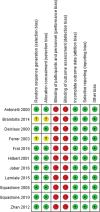Noninvasive Ventilation in Acute Hypoxemic Nonhypercapnic Respiratory Failure: A Systematic Review and Meta-Analysis
- PMID: 28441237
- PMCID: PMC5470860
- DOI: 10.1097/CCM.0000000000002361
Noninvasive Ventilation in Acute Hypoxemic Nonhypercapnic Respiratory Failure: A Systematic Review and Meta-Analysis
Abstract
Objective: To evaluate the effectiveness of noninvasive ventilation in patients with acute hypoxemic nonhypercapnic respiratory failure unrelated to exacerbation of chronic obstructive pulmonary disease and cardiogenic pulmonary edema.
Data sources: PubMed, EMBASE, Cochrane library, Web of Science, and bibliographies of articles were retrieved inception until June 2016.
Study selection: Randomized controlled trials comparing application of noninvasive ventilation with standard oxygen therapy in adults with acute hypoxemic nonhypercapnic respiratory failure were included. Chronic obstructive pulmonary disease exacerbation and cardiogenic pulmonary edema patients were excluded. The primary outcome was intubation rate; ICU mortality and hospital mortality were secondary outcomes.
Data extraction: Demographic variables, noninvasive ventilation application, and outcomes were retrieved. Internal validity was assessed using the risk of bias tool. The strength of evidence was assessed using Grading of Recommendations Assessment, Development, and Evaluation methodology.
Data synthesis: Eleven studies (1,480 patients) met the inclusion criteria and were analyzed by using a random effects model. Compared with standard oxygen therapy, the pooled effect showed that noninvasive ventilation significantly reduced intubation rate with a summary risk ratio of 0.59 (95% CI, 0.44-0.79; p = 0.0004). Furthermore, hospital mortality was also significantly reduced (risk ratio, 0.46; 95% CI, 0.24-0.87; p = 0.02). Subgroup meta-analysis showed that the application of bilevel positive support ventilation (bilevel positive airway pressure) was associated with a reduction in ICU mortality (p = 0.007). Helmet noninvasive ventilation could reduce hospital mortality (p = 0.0004), whereas face/nasal mask noninvasive ventilation could not.
Conclusions: Noninvasive ventilation decreased endotracheal intubation rates and hospital mortality in acute hypoxemia nonhypercapnic respiratory failure excluding chronic obstructive pulmonary disease exacerbation and cardiogenic pulmonary edema patients. There is no sufficient scientific evidence to recommend bilevel positive airway pressure or helmet due to the limited number of trials available. Large rigorous randomized trials are needed to answer these questions definitely.
Conflict of interest statement
Dr. S. Liu disclosed work for hire. The remaining authors have disclosed that they do not have any potential conflicts of interest.
Figures





Comment in
-
Beneficial Effects of Noninvasive Ventilation in Acute Hypoxemic Respiratory Failure: Caution With Findings From Meta-Analyses.Crit Care Med. 2017 Oct;45(10):e1100-e1101. doi: 10.1097/CCM.0000000000002567. Crit Care Med. 2017. PMID: 28915197 No abstract available.
-
The authors reply.Crit Care Med. 2017 Oct;45(10):e1101-e1102. doi: 10.1097/CCM.0000000000002592. Crit Care Med. 2017. PMID: 28915198 No abstract available.
-
Noninvasive Ventilation in Acute Respiratory Failure: Who Will Benefit?Crit Care Med. 2018 Feb;46(2):e184-e185. doi: 10.1097/CCM.0000000000002828. Crit Care Med. 2018. PMID: 29337823 No abstract available.
-
The authors reply.Crit Care Med. 2018 Feb;46(2):e185-e186. doi: 10.1097/CCM.0000000000002864. Crit Care Med. 2018. PMID: 29337824 No abstract available.
References
-
- Schnell D, Timsit JF, Darmon M, et al. Noninvasive mechanical ventilation in acute respiratory failure: Trends in use and outcomes. Intensive Care Med 2014; 40:582–591. - PubMed
-
- Keenan SP, Sinuff T, Burns KE, et al. ; Canadian Critical Care Trials Group/Canadian Critical Care Society Noninvasive Ventilation Guidelines Group: Clinical practice guidelines for the use of noninvasive positive-pressure ventilation and noninvasive continuous positive airway pressure in the acute care setting. CMAJ 2011; 183:E195–E214. - PMC - PubMed
-
- Brochard L, Mancebo J, Wysocki M, et al. Noninvasive ventilation for acute exacerbations of chronic obstructive pulmonary disease. N Engl J Med 1995; 333:817–822. - PubMed
-
- Pisani L, Mega C, Vaschetto R, et al. Oronasal mask versus helmet in acute hypercapnic respiratory failure. Eur Respir J 2015; 45:691–699. - PubMed
-
- Masip J, Roque M, Sánchez B, et al. Noninvasive ventilation in acute cardiogenic pulmonary edema: Systematic review and meta-analysis. JAMA 2005; 294:3124–3130. - PubMed
Publication types
MeSH terms
LinkOut - more resources
Full Text Sources
Other Literature Sources
Medical
Miscellaneous

